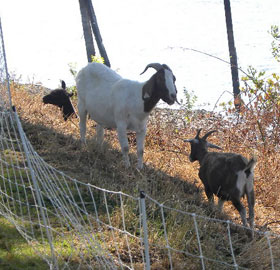Perhaps the best part of working for the USGA is the opportunity to view so many different ideas related to golf course maintenance. The experience of working with fescues at the 2011 U.S. Amateur Public Links and Women’s Amateur Public Links Championships was detailed in a previous update entitled, And Now for Something Completely Different. During a recent visit to Waverley Country Club in Portland, Ore., two other different ideas were viewed.
 | |
At Waverley CC in Portland, Ore., goats remove unwanted blackberry bushes while a llama serves to protect the goats from the resident coyote population. |
The use of goats is not uncommon in the West (see Goat Power!) with both Pasatiempo Golf Club in Santa Cruz, Calif., and Overlake Golf and Country Club in Medina, Wash., having very positive results. In both cases the plants removed by goats were thorny and thick. The expense for humans to perform the removal would have been nearly 10 times greater. Waverley CC had the same issue as Overlake G&CC with massive amounts of evergreen blackberries growing between the Willamette River and their golf course. Goats were an obvious solution. However, Waverley CC had an additional problem that resulted in an unusual solution. An active coyote population is known to roam near Waverley CC, thus some form of protection was needed for the goats. While Pasatiempo and Overlake used trained herding dogs, Waverley “employed” a llama. Apparently, these creatures are very protective of the goats. The llama is proving effective, but don’t get to close or it may spit in your eye!
 | |
The breakdown of sulfur pellets left over from Fourth of July fireworks can create turf loss of up to six inches or more in fairways. |
After viewing the natural removal of vegetation using goats, Mr. Brian Koffler, superintendent, took me to a great “can you guess what caused this” turf problem. Having no idea why the bare areas existed in the middle of the 18th fairway, Mr. Koffler took out a tee and found the problem – a small sulfur ball. It seems the membership uses the 18th fairway each year for their Fourth of July fireworks display. The sulfur balls are the remains from fireworks and cause a minor discoloration in the immediate area where they come to rest on the turf. The gradual breakdown of this concentrated sulfur ball eventually causes the complete loss of turf over an area that expands at least six inches across.
Larry Gilhuly will not spit in your eye nor will he eat blackberry bushes. He will be happy to visit your golf course as part of the Turf Advisory Service provided in the Northwest Region. Contact Larry at lgilhuly@usga.org or Derf Soller at dsoller@usga.org for information on visiting your golf facility in 2012 or next year.
